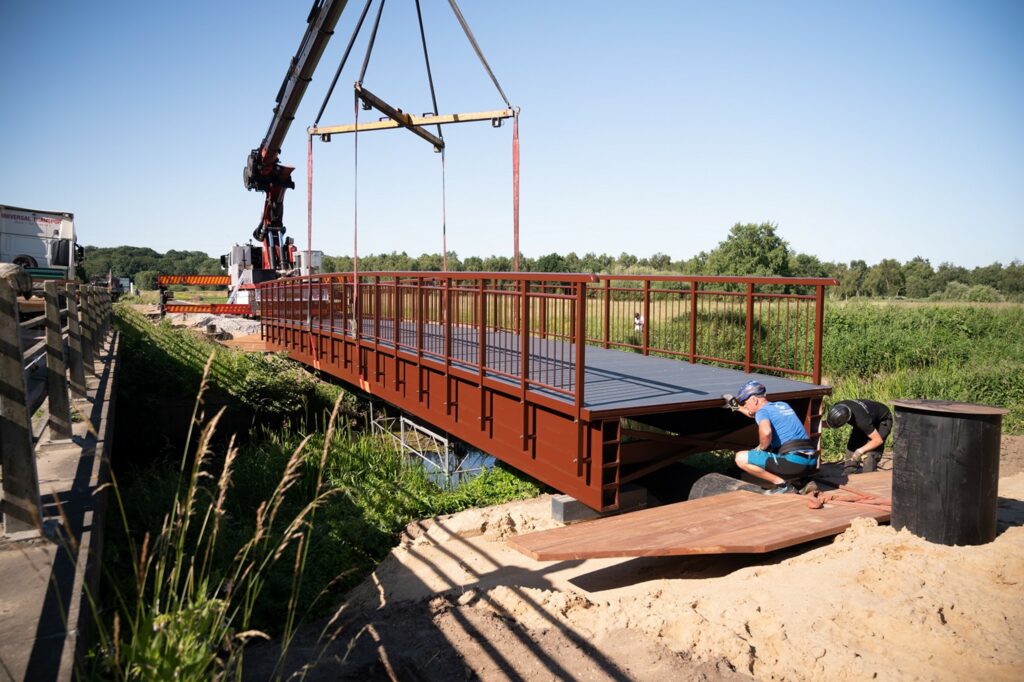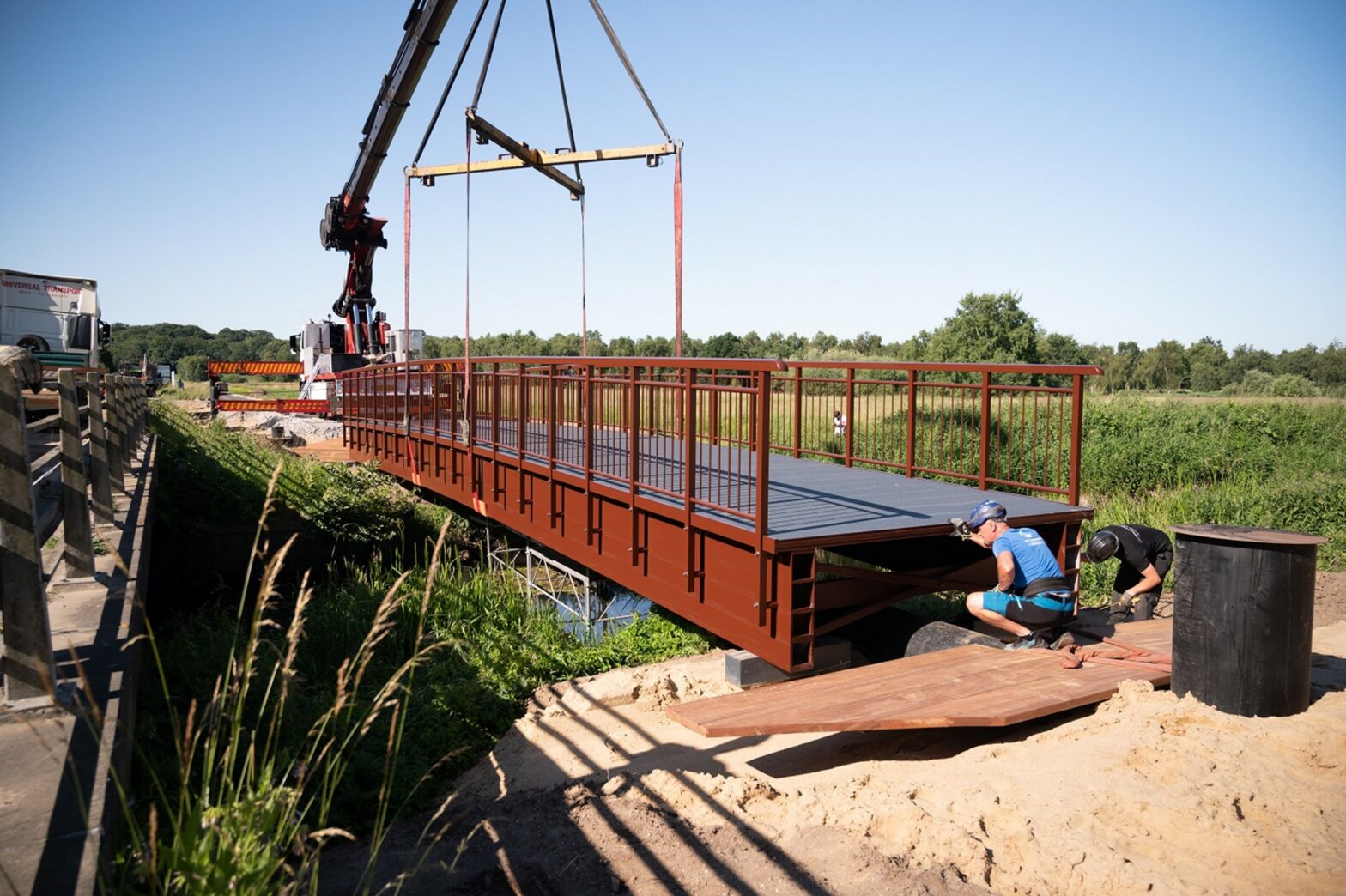Pultruded composites contribute to a more sustainable future for construction

Increasing energy and resource efficiency in the construction sector will be key to the EU’s ambition of achieving climate neutrality by 2050. By enabling the manufacture of strong, durable and lightweight products, composite materials can help the construction sector improve its environmental sustainability, as well as reduce total lifecycle costs. Pultruded composite parts answer the need for design flexibility, high performance, faster installation, corrosion resistance and low maintenance in a wide variety of building and infrastructure applications, from bridge decks to rebar for concrete, from railway platforms to building panels, stairs and fencing.
Composites and sustainability
Fibre reinforced polymer composites are versatile materials that provide an attractive combination of properties not available with traditional materials such as metals, concrete and wood. This has led to their growing adoption in a diverse range of industries where they can provide better performance and a longer lifespan than traditional materials. Composites are essential in the wind energy sector, where they enable the manufacture of the rotor blades required to power the larger, more efficient turbines being developed to meet ever-increasing demand for renewable energy. Substituting metal components with lightweight composite parts reduces the energy consumption, and CO2 emissions, of all forms of transportation – from cars and trucks, to aircraft, trains, ships and space vehicles. Lightweight can also lead to other benefits, such as easier installation on building and construction sites, for example.
| Properties of composite materials |
| ˗ High strength & lightweight ˗ Corrosion resistance & durability ˗ Design flexibility & parts consolidation ˗ Fire safety ˗ Thermal insulation ˗ Dimensional stability ˗ High and low temperature capabilities ˗ Electrical insulation ˗ Excellent dielectric properties |
Pultrusion is one of the few continuous processes for manufacturing composite parts. It is used to produce linear profiles with a uniform cross-section. A huge variety of solid and hollow profiles can be manufactured, in simple and complex cross-sectional shapes, including tubes, rods, I-beams, and T-profiles. In the pultrusion machine the reinforcing fibres are impregnated with resin and pulled through a heated die where curing takes place. The finished profiles are cut to length at the end of the line and can then be stored and used as structural units when required. Pultrusion is an automated, fast and efficient way of producing high performance composite parts. It allows for high fibre loading and accurately controlled resin content and pultruded parts therefore have excellent structural properties and are produced at a consistently high quality, minimising waste. The composite materials can be tailored to provide the optimum combination of properties for specific requirements. Profiles can be made in many colours and various coatings and surface finishes are possible. Pultruded products can be recycled at the end of their service life.
The future of construction
Climate change is putting the construction industry under immense pressure to improve its environmental sustainability. It is one of the largest global users of energy and raw materials and accounts for a huge share of CO2 emissions and solid waste generation. At the same time, the sector must respond to increased demands for improved performance (including more resilient infrastructure to withstand increasingly frequent severe weather events), with reduced total-cost-of-ownership (TCO). Working environments also need to be safer and water consumption, dust and noise reduced.
Analysts highlight a number of emerging trends. New materials and innovations in traditional materials will be needed to minimise the use of natural resources, enable a reduction of carbon footprint and facilitate circular economy practices. Choosing the optimum materials required for durability throughout the lifecycle will be increasingly important. Manufacturing must become more sustainable and supply chains optimised for sustainability. Increased use of lightweight materials will enable simpler factory production of modules and allow improved logistics. A shift to off-site production is also forecast. Today’s highly project-based construction process, where projects are developed from customer specifications and construction performed on site, is expected to become increasingly product-based in future. More structures are likely to be standardised products and prefabricated modules which are manufactured off site, where factory-controlled environments and automated processes can improve quality control and reduce waste. Foundations and groundwork on site can progress at the same time as offsite production so that projects can be completed faster with less disruption.
| Drivers for pultruded composites use in construction applications | |
| Property | Benefits |
| High strength-to-weight ratio | The same performance as traditional materials such as steel but at lower weightPossible to optimise strength and stiffness by varying the orientation of the reinforcements |
| Corrosion resistance & durability | Resistant to weather, UV exposure, moisture, seawater, a wide range of chemicals, insect attackImpact & scratch resistantLower maintenance requirements, longer maintenance intervals Longer service life, less frequent replacement Especially suitable for challenging environments (e.g. coastal, chemical), where traditional materials deteriorate quickly |
| Lightweight | Easier logistics & faster installation Reduced energy for transportation & on-site handlingLower requirements for labour & heavy-duty lifting machineryLess substantial supporting structures (e.g. bridge foundations) Lower energy use for moving parts (e.g. bascule bridges, lock gates) |
| Design flexibility & aesthetics | Parts consolidation – function integration, reduced number of parts & reduced need for joining (less fasteners)Shapes not possible in metals – innovative, resource-efficient designs Variety of moulded-in colours, coatings & surface finishes possible |
| Off-site fabrication & assembly | Efficient, automated process, with high quality control – high productivity with less waste Standardised products in high volumes e.g. popular construction products such as tubes, I-beams etc.Pre-assembly of modules & complete structures with reduced part count, facilitating installation on site |
| Thermal insulation | Reduced heat transfer & energy loss (e.g. window frames, thermal break components) A ‘warmer’ surface than materials like steel, parts such as handrails remain comfortable to touch in extreme hot or cold environments |
| Non-conductor of electricity | Can be safely used near electrical equipment (e.g. railways) No need for earthing |
Pultruded composites offer a good fit for these objectives in many ways. Pultruded parts can be assembled into modules or complete structures in the factory for faster installation on site with lower labour requirements, and less noise, dust and waste. Lightweight profiles allow more energy-efficient transportation and installation, and a longer service life combined with minimal maintenance can deliver a lower through-life carbon footprint together with reduced costs.
Pultruded composite parts such as profiles, gratings, box sections, beams, tubes and planks are increasingly found in a range of building, construction and infrastructure applications. Examples include bridge decks, fencing, stairs and handrails, access structures, train platforms, cladding, trench covers, street furniture, airport infrastructure, cable ducts, cladding, utility poles, modular building concepts, building facades, and window frames. In particular, excellent growth potential is seen in two large sectors of the infrastructure market where corrosion resistance and lightweight are key drivers for composites use – bridges and bridge decks, and rebar for reinforcing concrete.
The Answering a need for durable infrastructure
Maintaining, upgrading and replacing ageing bridges and other infrastructure made from traditional materials is a growing economic burden worldwide. Corrosion is also extremely costly for the environment, resulting in the utilisation of more resources over a structure’s lifetime, as well as more frequent replacement. Optimising an asset’s lifespan and minimising maintenance requirements are an important part of sustainable design.
Corrosion-resistant pultruded composites can offer durable solutions which require minimal maintenance, reducing lifecycle costs and environmental impact compared to alternative materials. Composite bridges are being designed to provide a service life of 100 years, whereas bridges constructed from wood can start to fail in as little as 15 years after initial installation. Although steel bridges can have a long design life, they require repainting every 20-30 years (depending on the particular bridge and its location) to protect them from corrosion. For large steel bridges, painting is a continuous task. Over recent years, pultruded glass fibre composite has become a highly popular choice for pedestrian and cycle bridges. Pre-fabricated ‘easy fit’ bridge decking planks, pre-assembled bridge modules and complete bridge ‘kits’ are now available. Standard products such as planks, profiles, gratings, girders, beams and handrails can be supplied in different sizes and colours, with wear-resistant or other finishes as required. Low-maintenance composite bridges are ideal for use near water or on the coast and in remote locations or sensitive environments where regular maintenance operations would be difficult or disruptive. In some cases, a composite bridge has been estimated to cost at least 50% less to maintain than a concrete or steel structure over its lifetime.
In addition to new builds, composites can also be used in bridge repair and upgrading projects. Pultruded decking planks can be combined with existing steel, wooden or concrete support structures (if they are still structurally sound), offering a more sustainable alternative to demolition and replacement of the existing bridge. Composites are also ideal for replacing wooden and steel parts such as housings, parapets and fencing when modernising bridges. The composite parts can be designed to replicate the look of the original bridge, which may be an important consideration for historic structures. And in cases where the load on an existing bridge’s substructure is approaching its maximum, a lightweight composite deck could, for example, be added to provide new pedestrian or cycle paths.
The second key driver for composites use in bridges is lightweight. A composite bridge can deliver the same performance as a steel structure with a weight saving of up to 50% or more, and even greater weight savings can be possible for concrete designs. This enables more streamlined bridge designs which require less substantial supporting structures and foundations, therefore greatly reducing consumption of materials and energy, and allowing faster installation. The design flexibility of composites and ability to consolidate several parts into one helps to optimise materials use and can reduce the need for secondary operations such as cutting and joining.
| Corrosion-resistant rebar for concrete |
| Rebar is another application of composites which is attracting considerable interest as a means to combat infrastructure corrosion. Reinforced concrete is one of the most widely used construction materials, but corrosion of the steel rebar (reinforcing rod) used to improve its tensile strength is a primary cause of cracking and spalling of concrete structures. Costly monitoring and maintenance programmes are required to ensure that structural integrity is not compromised. Corrosion-resistant pultruded rebar offers a way to extend the life of reinforced concrete bridges and other structures. It is especially effective for applications in challenging environments where steel corrodes quickly, such as docks and piers, as well as transport infrastructure exposed to de-icing salts, such as bridge decks and car parks. Composite rebar is also a good choice for structures in contact with freshwater as well as structures used in chemical plants, wastewater treatment facilities and other industrial sites. Pultruded rebar is available in a variety of standard shapes, diameters and lengths, and custom bars can be manufactured for specific requirements. It has a tensile strength twice that of steel rebar but at a quarter of the weight, making it easier to transport and realising significant labour savings in placing reinforcement on site. Less concrete cover is needed and maintenance requirements are much lower. These factors contribute to reduced environmental impact and can add up to substantial cost savings over the structure’s lifetime. |
Lightweight also results in easier logistics and simplified installation. Shipping of large, heavy steel, concrete and wood construction elements, and their subsequent installation on site with the use of electrically-powered hand-led and heavy-duty lifting machinery, have a massive impact on emissions. Rising energy prices are another compelling reason for reducing energy use. Since pultruded profiles are lighter in weight, they are more easily transported to the construction site, with lower fuel consumption, and easier to move on site, often reducing labour requirements and the capacity of equipment such as cranes. With less heavy elements and large moving equipment present, the construction site becomes safer. And unlike steel, ‘hot works’ such as welding are not needed, reducing fire risks.
The prefabrication of composite modules and complete structures off site also reduces on-site construction time. A composite railway or road bridge or deck can be lifted into place by crane overnight, leading to much less disruption to users and lower costs for infrastructure owners and operators. Faster installation of road bridges reduces the impact of traffic diversions, which can result in significant greenhouse gas (GHG) emissions. Lightweight composite bridges are ideal for inaccessible sites with no road access, where helicopters can be used to fly the structures into position. And for moveable structures, such as bascule and swing bridges, lightweight composite can lower energy consumption during use and reduce wear on other components.
While the relative importance of drivers such as corrosion resistance, lightweight and faster installation will vary greatly between different projects, an increasing number of case studies demonstrate that composite materials can offer a reduced total cost of ownership, particularly in environments where steel, concrete and wood deteriorate quickly.
A lifecycle approach
The construction industry’s efforts to improve sustainability will encompass the whole materials lifecycle, from choice of material, to more sustainable manufacturing, through to end-of-life management. The pultrusion industry is also striving to make the whole value chain more sustainable and circular. This includes design, materials and process developments to enable the production of higher performance products with lower use of resources and less waste. Potential applications for natural fibres and bio-based resins are being researched and trialled, and ways to better repair, reuse and recycle pultruded parts at the end of their service life are being advanced. Examples include the use of flax fibres and bio-based resins in bridge projects, and the development of sustainable end-of-life repurposing strategies for wind turbine blades (where the composite parts include pultruded spar caps).
As the construction industry looks to the future, the environmental and economic benefits of composite materials linked to easier logistics and installation, durability and low maintenance are becoming increasingly valued. As more projects demonstrate the benefits of composite materials, more customers are becoming aware of the possibilities they offer and standards covering the design, fabrication and installation of pultruded profiles (such as the forthcoming Eurocode for composites) are making it easier for the construction industry to implement these materials in their projects. With continued research and collaboration, pultrusion has the potential to contribute to a more sustainable future for construction and many other industries. EPTA will continue to promote the advancement of pultrusion technology and its applications and foster sustainable practices within the industry.
Please find here the press release as PDF file.
Agenda
- JEC World 2024 (official partner WPC) – Paris, 5-7 March 2024
 Paris
Paris - EPTA Board Meeting
 The next EPTA board meeting will take place at July,… Continue reading EPTA Board Meeting
The next EPTA board meeting will take place at July,… Continue reading EPTA Board Meeting


